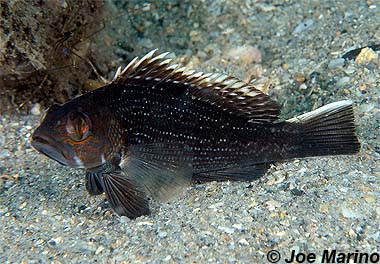
Centropristis striata
Not only do these fish have four color phases before they become a gray-brown to black, they also start as females and then change to males later in their lives. These stout, almond-shaped fish have pointed snouts, large eyes, and rounded fins, and they are mostly covered in large scales. They prefer shallow, rocky areas near jetties, piers and wrecks where they scavenge the sea floor for crustaceans and small fish.
Order: Perciformes
Family: Serranidae
Genus: Centropristis
Species: striata
Common Names
English language common names are black seabass and black sea bass. Other common names include fanfre noir (French), kalliomeriahven (Finnish), perchia striata (Italian), sainte-pierre (French), schwarzer zackenbarsch (German), serrano estriado (Spanish), Serrano-estriado (Spanish), sort havaborre (Danish), svart havabbor (Norwegian),and svart havsabborre (Swedish).
Importance to Humans
The black seabass is highly sought after by both recreational and commercial fisher, leading to overfishing. When caught on hook and line, this species provides a good fight making it fun to catch on light tackle. The meat is considered of high quality; it is marketed fresh and either fried, broiled, or baked for human consumption.
Suitable for captivity, the black seabass is often seen displayed in public aquarium facilities.
Conservation
According to the National Marine Fisheries Service, the black seabass population in the Middle Atlantic Bight is currently overexploited due to its popularity with commercial and recreational fishers. However, spawning stock indicates that the population has been relatively stable since the mid 1980s (Northeast Fisheries Science Center 1997).
The IUCN is a global union of states, governmental agencies, and non-governmental organizations in a partnership that assesses the conservation status of species.
> Check the status of the black seabass at the IUCN website.
Geographical Distribution
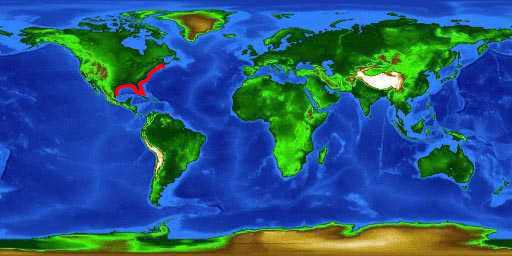
The black seabass is a warm temperate species that resides in the western Atlantic Ocean from Canada and Maine south to northeastern Florida and the eastern Gulf of Mexico. During cold winters, this species has been reported off southern Florida. This species is considered to be in three distinct populations for management purposes, based on geographic location: northern (north of Cape Hatteras), southern, and Gulf of Mexico. Some researchers consider the Gulf of Mexico population to be a subspecies: Centropristis striata melanus.
Habitat
This serranid is common around rock jetties and over rocky bottoms in shallow water, however they have also been reported in offshore waters to depths of 425 feet (130 m). Most of their time is spent along the bottom substrate, often forming congregations around formations on the bottom such as rock piles, wrecks, piers and pilings. At other times, it rests stationary, in either a head-down or head-up position. The dorsal fin is typically folded close to the body, only spread out as an aggressive posture to other seabass. Juveniles reside in the protective estuarine waters around jetties, piers, wrecks, and shell bottoms. They have also been reported in offshore waters.
Biology
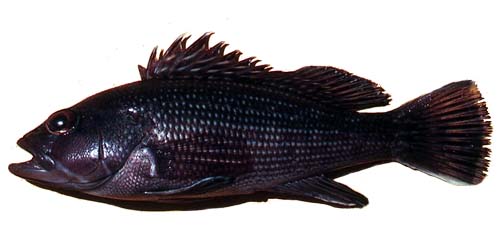
Distinctive Features
The body of the black seabass is stout and robust with a large head, pointy snout, and large oblique mouth. The eye is set high and there is one sharp flat spine located near the caudal end of the operculum. The upper jaw extends to the center of the eye. The dorsal fin is continuous with males having noticeably higher fins than females. The pectoral fins are long and rounded, extending almost to the anal fin. The pelvic fins are large and originate posterior of the pectoral fins. The rounded anal fins originate below the soft portion of the dorsal fin. The caudal fin has three lobes with one extended upper ray in adults; juveniles have rounded caudal fins. Males in breeding condition develop an adipose hump on the nape (in front of the dorsal fin). Large scales cover the body of this fish, but it is naked at the head.
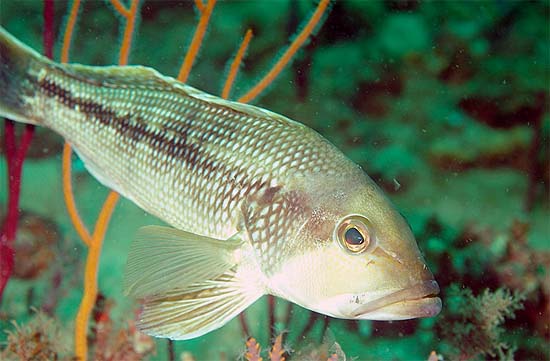
Coloration
The black seabass is a smoky gray, dusky brown or blue-black above, fading to a slightly paler color underside. The center of each scale is pale blue to white which forms longitudinal stripes along the back and sides of the fish. In addition, the sides sometimes appear mottled or with dark and light vertical crossbars. Males in breeding condition have vivid hues of fluorescent blue and green around the eyes and the nape while the females are lighter in color and brownish or blue-gray. Juveniles have four color phases: overall light gray phase with small dark spots; dark phase with pale white spots; striped phase with a horizontal dark stripe; and a barred phase having six vertical bars.
Dentition
The teeth of the black sea bass are arranged in wide bands with inner and outer teeth enlarged. The vomerine teeth appear in a wedge-shaped patch while the teeth on the palatine are arranged in a long narrow patch. Teeth are absent on the tongue.
Size, Age, and Growth
The maximum reported length of the black seabass is 26 inches (66.0 cm) total length (TL) however it more commonly reaches lengths of 12 inches (30.0 cm) TL. The maximum published weight is 9.5 pounds (4.3 kg). Sexual maturity is reached at approximately 7.5 inches (19 cm) TL and the maximum reported lifespan is 10 years.
Food Habits
Black seabass are carnivorous bottom feeders, feeding primarily on crabs and shrimps along with small fishes, tunicates, juvenile lobsters, and barnacles. Juveniles feed during the day as visual predators, feeding on benthic crustaceans including isopods, amphipods, small crabs, sand shrimp, and copepods, along with other epibenthic organisms such as mysids and small fishes.
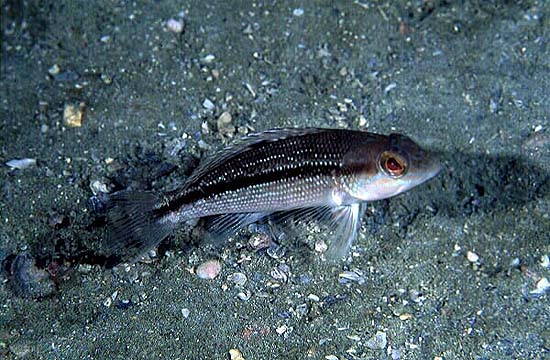
Reproduction
Black seabass are protogynous hermaphrodites. Individuals typically function first as females, then undergoing sexual succession and becoming functional males.The northern population of this species (north of Cape Hatteras) spawns buoyant pelagic eggs on the continental shelf during the spring through fall months. Spawning begins in the spring in the southern portion of this population and occurs later toward the more northern range of this northern population. The eggs are pelagic, measuring 0.9-1.0 mm in diameter. Hatching occurs after about 75 hours in water temperatures of 16 degrees Celsius. The larvae remain pelagic until reaching lengths of approximately 13 mm SL at which time they either become demersal or estuarine.
Predators
Documented predators of the black seabass include striped bass (Morone saxatilis), bluefish (Pomatomus saltatrix), weakfish (Cynoscion regalis), bignose shark (Carcharhinus altimus) and dusky shark (Carcharhinus obscurus).
Taxonomy
The black seabass was described as Centropristis striata by Linnaeus in 1758. Synonyms referring to this species in past scientific literature include Centropristes striata Linnaeus 1758, Labrus striatus Linnaeus 1758, Centropristes melanus Ginsburg 1952, and Centropristis melana Ginsburg 1952. The family, Serranidae, is a large family of fishes within the order Perciformes. Serranidae includes approximately 450 species and includes the seabasses and groupers. The species name striata can be translated from Latin as “lines”, describing the banding pattern on the body of this fish.
Prepared by: Cathy Bester